Diary anglers monitoring Mallacoota Inlet
The Victorian angler diary program has been operating in Mallacoota Inlet since 1997/98 and is currently funded by the Recreational Fishing Grants Program. Volunteer anglers have been contributing detailed information about their fishing trips including their time spent fishing, fishing location, species targeted and caught, fish lengths, number of rods and baits and hook type/sizes used.
Information collected by these volunteer anglers improves our understanding of fish stocks in Mallacoota Inlet in particular black bream and dusky flathead by providing information on:
- Abundance of fish. Catch rates (fish caught per angler hour) of key species can be used as a measure of fish abundance. Catch rates can indicate whether there has been an increase or decrease in the population over time
- Health of the fishery. The length and ages of fish caught by anglers indicates the health of the fishery and can be used to forecast catch trends 2 to 3 years in advance
- Profile of the fishery. Angler diarists give an insight into the species targeted and caught in Mallacoota Inlet as well as Information on which fish are kept and released.
- Local knowledge. Anglers provide their opinions on the status of key fish stocks and comment on trends in fish abundance over the past 5 years.
Angler diarists
Volunteer anglers contribute to the angler diary program as either a 'research' angler or a 'general' angler. General anglers record information from their normal fishing trips. Research anglers target key species and if necessary alter their fishing techniques to catch the largest possible size range of the targeted species, including undersize fish.
Abundance of fish
Angler diarists recorded 55 trips for black bream and 25 trips for dusky flathead in Mallacoota Inlet during 2010/11.
The catch rates (fish per angler hour) of black bream have declined over the past three years and are lower than the averages over the past 5 and 10 years. Catch rates of dusky flathead were higher in 2010/11 than the previous year and similar to the 5 year average.
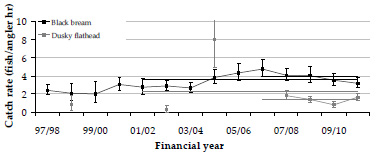
Health of the fishery
Data collected by angler diarists in Mallacoota Inlet suggest that while the populations of black bream and dusky flathead are variable from year to year, they are resilient, in a healthy condition, and showing no evidence of a persistent decline in abundance.
Black bream
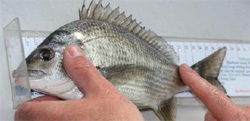
Angler diarists measured over 250 black bream in Mallacoota Inlet during 2010/11. These bream:
- Ranged in length from 14 to 44 cm Total Length (TL)
- Were 1 to 21 years of age; most bream caught were 2–3 years old (62%)
- Were mostly undersize (69%). These bream are expected to recruit to the fishery over the next few years.
Dusky flathead

Anglers measured over 100 dusky flathead in Mallacoota Inlet during 2010/11. These flathead:
- Ranged in length from 19 to 80 cm TL
- Were 1 to 14 years of age in 2009/10 (no dusky flathead were aged during 2010/11); most dusky flathead were 3–5 years old
- Had higher catch rates this year than in 2009/10
- Were mostly below 50 cm TL (94%). There is concern over the decline in large dusky flathead (>50 cm TL), suggesting the population should be closely monitored in the future.
Profile of the fishery
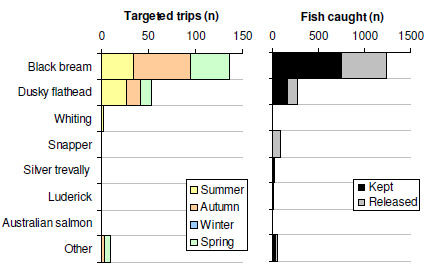
Over the past two years:
- 13 general anglers recorded catch information during 202 trips in Mallacoota Inlet. Anglers caught over 1700 fish
- General angler diarists fished mainly in autumn (40%), summer (31%) and spring (29%). No trips were undertaken during winter
- Bream were targeted most often (67% of trips). Over 1200 bream were caught and 61% of these fish were kept
- Dusky flathead were also targeted frequently (27% of trips). General anglers caught 273 dusky flathead and 60% of these fish were kept
- Targeting for bream and dusky flathead were similar during the summer period. Bream were targeted more frequently than flathead in the autumn and spring periods
- Other species were also targeted and caught on occasion.
Local knowledge
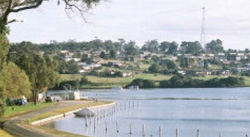
Five angler diarists were asked how last years fishing compared with the previous 3–4 years. Anglers thought:
- The average size of black bream had increased over the past 5 years while dusky flathead had decreased or were a similar size
- The abundance of black bream had increased or was similar while the abundance of dusky flathead had declined last year in comparison to the previous 3–4 years.
- Black bream and dusky flathead stocks are in good condition. Some anglers felt black bream stocks are improving while one angler felt dusky flathead stocks in are bad condition.
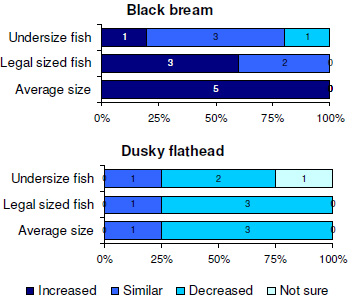
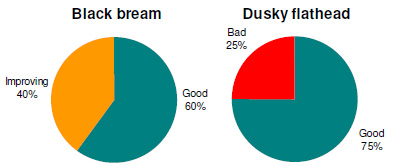
Get involved
Further information on the Angler Diary Program
If you would like to get involved or need a new diary contact the Fisheries Research Branch on (03) 5258 0111
